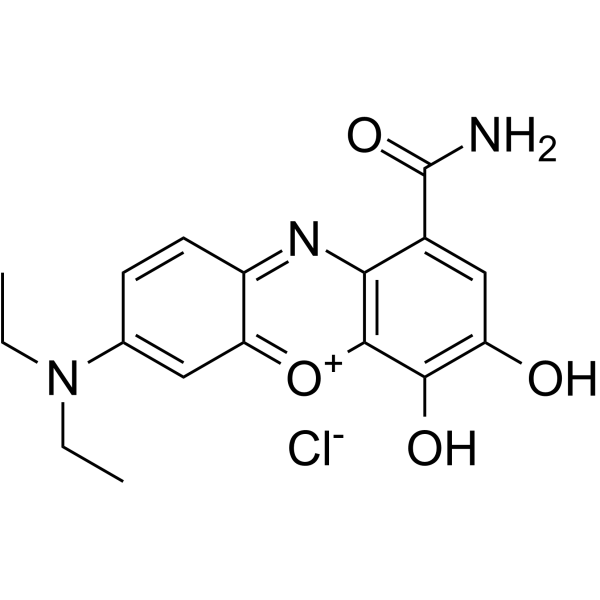C.I. Mordant Blue 14 (8CI)

C.I. Mordant Blue 14 (8CI) structure
|
Common Name | C.I. Mordant Blue 14 (8CI) | ||
|---|---|---|---|---|
| CAS Number | 1562-90-9 | Molecular Weight | 363.796 | |
| Density | N/A | Boiling Point | 431.7ºC at 760mmHg | |
| Molecular Formula | C17H18ClN3O4 | Melting Point | 227-230 °C | |
| MSDS | Chinese USA | Flash Point | 214.9ºC | |
Use of C.I. Mordant Blue 14 (8CI)Celestine Blue is a electroactive indicator in DNA biosensors. Celestine Blue is strongly adsorbed on the spinel phases and CNT (carbon nanotubes), facilitates dispersion, acts as a capping agent and allows for the fabrication of spinel decorated CNT. Celestine Blue is an efficient charge transfer mediator, which allows for significant improvement of capacitive behavior. TiO2 nanoparticles doped with Celestine Blue can be used as a label in a sandwich immunoassay for the hepatitis C virus (HCV) core antigen[1][2][3]. |
| Name | Celestine blue |
|---|---|
| Synonym | More Synonyms |
| Description | Celestine Blue is a electroactive indicator in DNA biosensors. Celestine Blue is strongly adsorbed on the spinel phases and CNT (carbon nanotubes), facilitates dispersion, acts as a capping agent and allows for the fabrication of spinel decorated CNT. Celestine Blue is an efficient charge transfer mediator, which allows for significant improvement of capacitive behavior. TiO2 nanoparticles doped with Celestine Blue can be used as a label in a sandwich immunoassay for the hepatitis C virus (HCV) core antigen[1][2][3]. |
|---|---|
| Related Catalog | |
| References |
| Boiling Point | 431.7ºC at 760mmHg |
|---|---|
| Melting Point | 227-230 °C |
| Molecular Formula | C17H18ClN3O4 |
| Molecular Weight | 363.796 |
| Flash Point | 214.9ºC |
| Exact Mass | 363.098572 |
| PSA | 112.82000 |
| LogP | 0.32270 |
| Personal Protective Equipment | Eyeshields;Gloves;type N95 (US);type P1 (EN143) respirator filter |
|---|---|
| Hazard Codes | Xi: Irritant; |
| Risk Phrases | R36/37/38 |
| Safety Phrases | S22-S24/25 |
| RIDADR | NONH for all modes of transport |
| WGK Germany | 3 |
| HS Code | 2934999090 |
| HS Code | 2934999090 |
|---|---|
| Summary | 2934999090. other heterocyclic compounds. VAT:17.0%. Tax rebate rate:13.0%. . MFN tariff:6.5%. General tariff:20.0% |
|
A multichromatic stain for Lowicryl K4M embedded tissues.
Biotech. Histochem. 1(1) , 35-6, (1991) A staining procedure using celestine blue and chromotrope 2R for Lowicryl K4M embedded tissues is presented. The stain produces a reliable multichromatic stain for light microscopy on Lowicryl embedde... |
|
|
Hematoxylin shortages: their causes and duration, and other dyes that can replace hemalum in routine hematoxylin and eosin staining.
Biotech. Histochem. 85(1) , 55-63, (2010) The origins of repeated hematoxylin shortages are outlined. Lack of integration in the hematoxylin trade exacerbates the problems inherent in using a natural product. Separate corporations are engaged... |
|
|
A hematoxylin and eosin-like stain for glycol methacrylate embedded tissue sections.
Stain Technol. 56(1) , 39-43, (1981) A staining procedure is described for use with glycol methacrylate embedded tissue sections which does not stain the plastic embedment or remove the sections from the glass slides. The basic dye is ce... |
| Phenoxazin-5-ium, 1-(aminocarbonyl)-7-(diethylamino)-3,4-dihydroxy-, chloride (9CI) |
| Mordant Blue 14 |
| C.I. Mordant Blue 14 (8CI) |
| CELESTINE BLUE |
| 1-Carbamoyl-7-(diethylamino)-3,4-dihydroxyphenoxazin-5-ium chloride |
| MFCD00011927 |
| 7-(diethylamino)-4-hydroxy-3-oxophenoxazin-10-ium-1-carboxamide,chloride |
| Phenoxazinium, 1-(aminocarbonyl)-7-(diethylamino)-3,4-dihydroxy-, chloride (1:1) |
| EINECS 216-346-2 |

